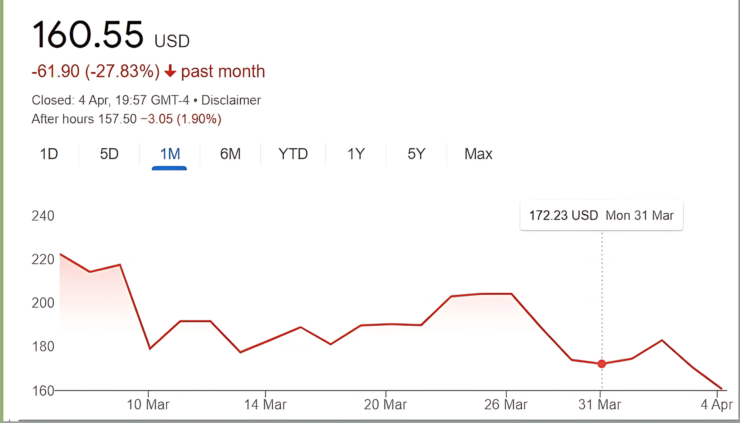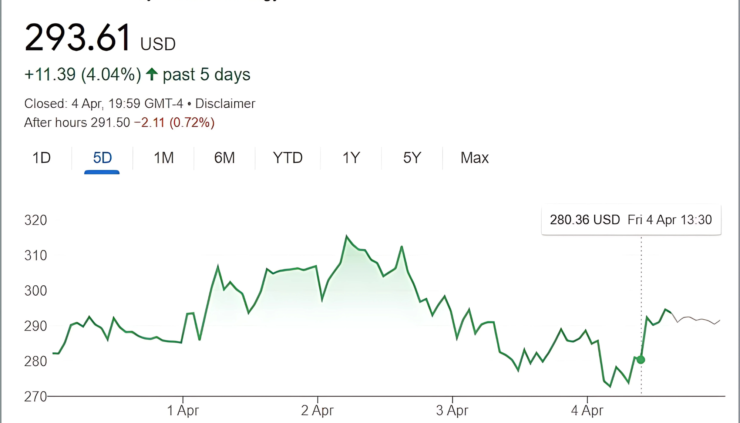Coinbase shares tumbled sharply on Friday, hitting their lowest level since September 2024, as U.S. markets reacted to escalating trade tensions triggered by President Donald Trump’s sweeping tariff plans.
The stock fell over 13% during intraday trading before paring some losses to close down 6.38%. Currently, Coinbase sits roughly 54% below its 52-week high of $349.75, underscoring the growing pressure on crypto-exposed equities during periods of macroeconomic instability.
The selloff in COIN mirrors broader market distress, with investors retreating from risk-sensitive assets amid fears of a prolonged trade conflict. Other crypto-linked stocks followed suit, deepening the sector’s losses and reinforcing concerns about volatility in digital asset markets when traditional financial systems are under strain.

Bitcoin Holds Steady While Miners and Crypto-Heavy Stocks Extend Losses
Bitcoin mining companies and major crypto-aligned firms continued to slide on Friday, extending what has already been a brutal month for publicly traded entities exposed to digital assets. The downturn comes just days after the mining sector posted its worst monthly performance on record.
Riot Platforms and Bitdeer Technologies led the losses, falling 4% and 8.44%, respectively, during early afternoon trading. MARA Holdings and CleanSpark also dropped 0.75% and 2.5%, adding to the cumulative decline across the space.
Outside the mining sector, companies with significant Bitcoin holdings saw similar pressure. Tesla shares fell 10% on the day, while fintech giant Block declined 7.34%.
Strategy, the company formerly known as MicroStrategy and the largest corporate holder of Bitcoin—controlling more than 2.5% of the asset’s total supply—briefly traded in the red before reversing course and posting gains of over 3%.

Despite the turbulence in equities, Bitcoin itself remained relatively resilient. The asset rose more than 3% over the past 24 hours, outperforming both the S&P 500 and Nasdaq, which each dropped approximately 5%.
This divergence between BTC and traditional risk assets continues to fuel discussions about whether Bitcoin is beginning to decouple from broader market sentiment—a shift that could reshape its narrative as both a risk-on asset and a potential hedge.
“Liberation Day” Tariffs Spark Renewed Economic Fears
Driving much of the recent market turmoil is President Donald Trump’s sweeping tariff initiative, announced Thursday. The plan introduces a 10% blanket import tax on all goods entering the U.S., while escalating duties on select nations under so-called “reciprocal” trade rules. These measures are aimed at counterbalancing what the administration views as unfair trade imbalances.
Under the policy, countries such as China will be hit hardest, facing a 34% reciprocal tariff layered on top of an existing 20%, pushing the total effective rate above 50%. Southeast Asian exporters have also been targeted, with Cambodia and Vietnam now facing tariffs of 49% and 46%, respectively. Even traditional allies like Australia will not be exempt, falling under the 10% baseline rate.
While the administration claims the tariffs will revitalize domestic manufacturing and level the global trade playing field, economists have raised red flags over the broader consequences.
The recent turbulence across crypto and equity markets illustrates how vulnerable investor sentiment remains in the face of unpredictable macroeconomic policy. As global trade tensions escalate and capital flight from risk assets intensifies, crypto firms will likely need to reassess short-term strategies while navigating an increasingly volatile regulatory and financial landscape.
Quick Facts
- Coinbase’s stock declined over 13% during Friday’s session, closing 6.38% down and marking a seven-month low.
- Cryptocurrency mining firms, including Riot Platforms and Bitdeer, experienced significant share price reductions amid market volatility.
- Despite broader market declines, Bitcoin’s price increased by over 3%, outperforming major equity indices.
- The correlation between Bitcoin and the S&P 500 decreased, indicating a potential shift in their inter-market relationship.





